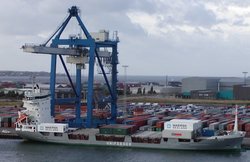Container ship
|
|
Container ships are cargo ships that carry all of their load in truck-size containers, in a technique called containerization. However, cargo that is too big to carry in containers can be handled using so-called flat racks, open top containers and platforms.
They are designed in such a manner that no space is wasted. Their capacity is measured in TEU (Twenty-foot Equivalent Units). This is the number of 20 ft containers that it can carry. The majority of containers used today are 40 ft in length. Above a certain size, container ships do not carry their own loading gear. Hence loading and unloading can only be done at ports with the necessary cranes. However, smaller ships with capacities up to 2 900 TEUs are often equipped with their own cranes.
Informally known as "box boats," they carry the majority of the world's dry cargo. There are large main line vessels that ply the deep sea routes, then many small "feeder" ships that supply the large ships at centralized hub ports. Most container ships are propelled by diesel engines, and have crews of between 20 and 40 people. They generally have a large accommodation block at the stern, directly above the engine room. Container ships now carry up to 8,000 containers on a voyage.
The first container ships were converted tankers, built up from surplus tanker Liberty ships after World War II. Container ships are by now, all purpose-built and, as a class, they are the biggest cargo ships on the oceans, right after crude oil carriers, or tankers.
Shipyards
Large container ships (over 7000 TEU) have been built in the following shipyards:
- Odense Steel Shipard, Denmark
- Hyundai Heavy Industries, South Korea
- Samsung Heavy Industries, South Korea
- Deawoo Heavy Industries, South Korea
- IHI. Kure. Japan
- Mitsubishi Heavy Industries, Nagasaki. Japan
The biggest ships (listed by TEU) in the world are:
| Built | Name | Length o.a. | Beam | TEU | BRT | Owners |
|---|---|---|---|---|---|---|
| 2005 | Colombo Express | 335.07 m | 42.87 m | 8700 | 93750 | Hapag-Lloyd/Germany |
| 2004 | CSCL Europe | 334.00 m | 42.80 m | 8498 | 99500 | China Shipping Container Line |
| 2003 | OOCL Shenzhen | 322.97 m | 42.80 m | 8063 | 89097 | OOCL/Hongkong |
| 2003 | Axel Maersk | 352.10 m | 42.80 m | 7226 (8300) | 93496 | Maersk Sealand/Denmark |
| 1997 | Sovereign Maersk | 346.98 m | 42.80 m | 6600 (8000) | 91500 | Maersk Line/Denmark |
| 1996 | Regina Maersk | 318.24 m | 42.80 m | 6000 (7000) | 80500 | Maersk Line/Denmark |
| 1995 | OOCL Hongkong | 276.02 m | 40.00 m | 5344 | 66046 | OOCL/Hongkong |
| 1991 | Hannover Express | 294.00 m | 32.30 m | 4639 | 53783 | Hapag-Lloyd/Germany |
| 1988 | Marchen Maersk | 294.12 m | 32.22 m | 4300 | 53600 | Maersk Line/Denmark |
| 1984 | Louis Maersk | 270.00 m | 32.30 m | 3390 (3700) | 53300 | Maersk Line/Denmark |
| 1981 | Frankfurt Express | 287.73 m | 32.28 m | 3430 | 57540 | Hapag-Lloyd/Germany |
| 1972 | Hamburg Express | 287.70 m | 32.20 m | 3010 | 58088 | Hapag-Lloyd/Germany |
| 1972 | Tokyo Bay | 289.32 m | 32.26 m | 2961 | 58889 | OCL then P&O/GB |
| 1971 | Kamakura Maru | 290.00 m | 32.20 m | 2500 | 59000 | NYK/Japan |
| 1970 | Sydney Express | 217.00 m | 30.58 m | 1665 | 27407 | Hapag-Lloyd/Germany |
| 1969 | Encounter Bay | 227.31 m | 30.56 m | 1572 | 28800 | OCL then P&O/GB |
Note
- The size of a container ship is defined throughout the world in terms of TEU capacity. The exception is the Maersk Sealand line. It does not quote the TEU capacity, but the maximum load capacity in terms of filled TEUs each with a 14 tonne load. This value is always less than the raw TEU capacity. These values are noted in the table above.
CMA_CGM_Balzac.jpg
Template:Water-stubde:Containerschiff fr:Porte-conteneurs it:Portacontainer nl:Containerschip zh:貨櫃船

